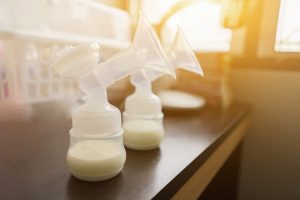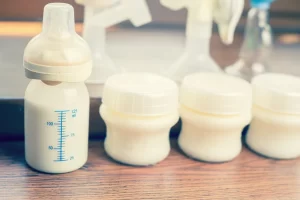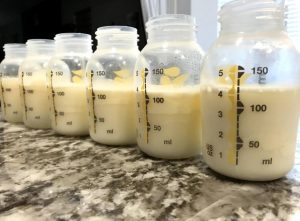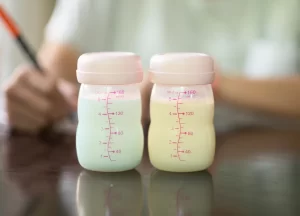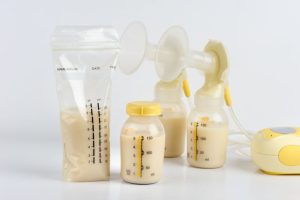Key Highlights
- Express and store breast milk using clean, sterilized BPA-free containers to maintain safety and nutrition.
- Freshly expressed breast milk can be stored at room temperature for up to four hours, in the refrigerator for up to four days, and in the freezer for up to twelve months.
- Thaw frozen breast milk in the refrigerator or under warm running water, and never refreeze once thawed.
- To preserve nutrients, minimize exposure to light and air, and gently swirl milk to mix separated fat.
- High lipase activity in breast milk, causing a soapy taste, can be managed by scalding milk right after expressing.
- Expressed milk should be stored in small quantities (2-4 ounces) to reduce waste and labeled with the date of expression.
- Use breast milk storage bags for efficient, flat freezing and to prevent freezer burn.
- For travel, transport breast milk in insulated coolers with ice packs, and be aware of airport security regulations.
- Breast milk is especially beneficial for sick or premature babies, and workplaces should support breastfeeding mothers with adequate breaks and private spaces.
- Stay informed and engage in community support for the latest breastfeeding and milk storage practices.
Introduction
Breast milk is a vital source of nutrition for infants, particularly in the first six months of life. For many mothers, expressing and storing breast milk can be an essential aspect of their breastfeeding journey, enabling them to continue breastfeeding after returning to work, share feeding responsibilities, or simply have a supply of milk available when needed. Proper storage methods are crucial to ensure that the milk remains safe and retains its nutritional and immunological properties. Here is a comprehensive guide on safe and effective storage methods for expressed breast milk.
Understanding Breast Milk Composition
Before delving into storage methods, it’s important to understand the composition of breast milk. Breast milk contains a complex blend of nutrients, enzymes, and antibodies tailored to the infant’s needs. These components can be sensitive to temperature and storage conditions, which is why proper handling is critical.
Expressing Breast Milk
1. Hygiene
Always wash your hands thoroughly before expressing milk. Use clean equipment that’s been sterilized or washed in hot, soapy water and thoroughly rinsed.
2. Methods of Expression
Breast milk can be expressed manually or with a breast pump. Choose a method that’s comfortable and effective for you.
Storage Containers
1. Types of Containers
Use clean, BPA-free containers made specifically for breast milk storage, such as hard plastic bottles or breast milk storage bags. Glass containers can also be used but are more prone to breaking.
2. Preparing Containers
Sterilize or wash the containers in hot, soapy water before use. Ensure they’re completely dry to avoid contamination.
Where and How to Store Expressed Breast Milk
Also Read : Busy Mom’s Guide: Easy-to-Clean Hands-Free Breast Pumps
1. Room Temperature
Freshly expressed breast milk can be kept at room temperature (up to 77°F or 25°C) for up to four hours. It should be covered and kept as cool as possible.
2. Refrigerator
Store expressed milk in the back of the refrigerator, where the temperature is most consistent, for up to four days. Avoid storing it in the door, where the temperature fluctuates with opening and closing.
3. Freezer
For longer storage, breast milk can be frozen. In a freezer compartment inside a refrigerator, it can be stored for two weeks. In a separate freezer unit of a fridge, it can last for up to six months, and in a deep freezer at -4°F (-20°C), it can be stored for up to 12 months.
4. Labeling
Always label milk with the date it was expressed. Use the oldest milk first.
Thawing and Warming Stored Breast Milk
1. Thawing
Thaw frozen breast milk slowly in the refrigerator or more quickly by placing it under warm running water. Do not use a microwave to thaw or heat breast milk, as this can destroy nutrients and create hot spots that could burn the baby.
2. Warming
To warm breast milk, place the container in a bowl of warm water. Test the milk’s temperature before feeding, ensuring it’s lukewarm, not hot.
3. Use After Thawing
Once thawed, breast milk should be used within 24 hours and never refrozen.
Tips for Safe Storage
1. Avoid Contamination
Ensure that the containers are sealed tightly to prevent contamination.
2. Storage Quantity
Store in small quantities (2-4 ounces) to avoid waste, as unused milk left after a feed should be discarded.
3. Mixing Milk
If adding fresh milk to frozen milk, cool the fresh milk in the refrigerator first. The quantity of fresh milk shouldn’t be more than what’s already in the container.
Maximizing Nutritional Value
While storage methods are essential for safety, they also play a crucial role in preserving the nutritional and immunological value of breast milk.
1. Minimizing Exposure
Limit the exposure of breast milk to light and air to preserve essential nutrients, such as vitamins and antioxidants.
2. Gradual Thawing
Gradually thawing breast milk in the refrigerator helps maintain its quality. Rapid temperature changes can affect the milk’s composition.
Handling Expressed Milk in Special Circumstances
1. Premature Infants
For premature or hospitalized infants, follow the hospital’s guidelines or consult with neonatal staff for specific storage instructions.
2. Donated Milk
If using donated breast milk, ensure it’s from a reputable milk bank where it’s screened, pasteurized, and stored following strict guidelines.
Cleaning and Sterilization
Proper cleaning and sterilization of pumping equipment and storage containers are vital.
1. Cleaning Process
After each use, dismantle the breast pump parts and wash them in hot, soapy water. Use a brush dedicated to cleaning baby feeding equipment.
2. Sterilization Methods
Steam sterilizers, boiling water, or special sterilization bags for microwaves can be used. Follow the manufacturer’s instructions for sterilization methods.
Freezing Tips for Long-Term Storage
When freezing breast milk for long-term storage, consider these tips:
1. Leave Space
Leave about an inch of space at the top of the container, as breast milk expands when frozen.
2. Flat Freezing
If using breast milk storage bags, freeze them flat for efficient use of space and quicker thawing.
3. Avoiding Freezer Burn
To prevent freezer burn, ensure that containers are airtight and moisture-proof.
Traveling with Expressed Milk
For mothers on the go, transporting breast milk requires careful planning.
1. Coolers
Use an insulated cooler with ice packs to keep breast milk cold.
2. Airport Security
Familiarize yourself with airport security rules regarding carrying breast milk. In many cases, you’re allowed to carry more than the standard liquid limit.
Breast Milk Storage Myths and Misconceptions
1. Refrigerated Milk Smell
Sometimes, breast milk may smell soapy or metallic when refrigerated due to the breakdown of fats by enzymes. This doesn’t necessarily mean the milk is spoiled.
2. Mixing Temperatures
It’s safe to mix milk of different temperatures, provided the fresh milk is cooled in the refrigerator before being added to previously chilled or frozen milk.
Supporting Breastfeeding and Pumping at Work
Workplaces play a significant role in supporting breastfeeding mothers.
1. Break Time
Employers should provide adequate breaks for expressing milk.
2. Private Space
A clean, private space (not a bathroom) for pumping is essential.
3. Storage Facilities
Access to a refrigerator or cooler for storing expressed milk during work hours is beneficial.
Beyond the Basics: Advanced Storage Insights
Expanding upon basic storage methods, there are additional considerations and advanced tips that can further enhance the safety and quality of stored breast milk.
Understanding Changes in Stored Milk
1. Nutrient Stability
While some nutrients may degrade slightly over time, stored breast milk still provides immense health benefits. The key is to use the oldest stored milk first to ensure optimal nutrient retention.
2. Fat Separation
It’s normal for the fat in breast milk to separate and rise to the top when stored. Gently swirl (don’t shake vigorously) the milk to mix the fat back in before feeding.
Dealing with Excess Lipase Activity
Some women have high lipase activity in their breast milk, which can cause the milk to develop a soapy or metallic taste when stored:
1. Scalding Milk
If your baby refuses milk due to this taste, scalding the milk (heating it just until bubbles form around the edges, then quickly cooling) right after expressing can deactivate the lipase.
2. Testing
Before committing to scalding all your milk, test this method with a small amount to see if it makes a difference for your baby.
Creative Uses of Excess or Older Milk
If you find yourself with more expressed milk than your baby can consume, consider these options:
1. Milk Baths
Older milk, which may not be optimal for feeding, can be used for milk baths, which are believed to benefit a baby’s skin.
2. Donating
Consider donating excess milk to a milk bank or a mother in need, following safe donation practices.
Storage in Different Scenarios
1. Power Outages
During a power outage, keep the freezer closed to maintain the temperature. A full freezer will keep the temperature for about 48 hours.
2. Natural Disasters or Emergencies
Have a plan for storing or using your breast milk during emergencies. Portable coolers and ice packs are essential in these scenarios.
Breast Milk as Medicine
Sick Babies
Breast milk is especially beneficial for sick or premature babies, offering vital antibodies and easy digestibility. Prioritize breast milk feeding in these situations, following any specific storage guidelines provided by healthcare professionals.
Supporting Breastfeeding Education
1. Community Support
Engage in community support groups or online forums for breastfeeding mothers to share experiences and tips about breast milk storage and feeding.
2. Continual Learning
Stay updated with the latest research and recommendations from health organizations regarding breast milk storage.
Conclusion
Storing expressed breast milk safely is essential for maintaining its quality and ensuring that your baby receives the full benefits of your milk even when you’re apart. By following these guidelines, you can ensure that your stored breast milk remains a safe, nutritious, and convenient feeding option for your baby. Remember, each mother and baby are unique, so what works best may vary. Always consult with a lactation consultant or healthcare provider if you have specific concerns or questions about breast milk storage and handling.
Acknowledgements
We extend our heartfelt gratitude to Sarah Thompson, Michael Brown, and Laura Rodriguez for their invaluable input and dedication to the advancement of this manuscript.
Source-
In presenting “The Comprehensive Guide: Safe and Effective Storage Methods for Expressed Breast Milk,” our editorial philosophy is grounded in accuracy and trustworthiness. We meticulously gather our data from authoritative sources, encompassing peer-reviewed scientific research, leading infant nutrition journals, and insights from renowned lactation consultants and pediatricians. Our allegiance to veracity and practicality is central, as we consciously steer clear of unsubstantiated information. To fully understand our editorial criteria for the safe and effective storage of expressed breast milk, designed to provide reliable guidance for parents, we invite you to explore the dedicated section on our website.
Possible source references for Safe and Effective Storage Methods for Expressed Breast Milk
- Raising Children – Expressing and storing breastmilk
- Womens Health – Pumping and storing breastmilk
- Centers for Disease Control and Prevention – Proper Storage and Preparation of Breast Milk


